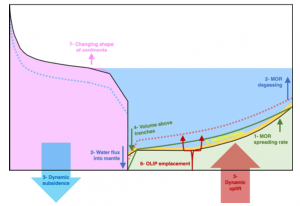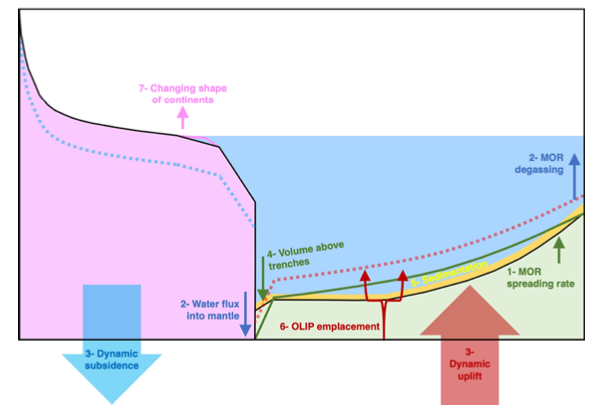 The sedimentary rock record suggests that global sea levels may have fluctuated by hundreds of meters throughout Phanerozoic times. Long-term (10–80 Myr) sea level change can be inferred from paleogeographic reconstructions and stratigraphic methods can be used to estimate sea level change over 1–10 Myr in tectonically quiescent regions assumed to be stable. Plate tectonic reconstructions and mantle flow models make it possible to isolate, quantify and estimate the contribution of different solid Earth mechanisms to sea level change through time, including: the volume of water deeper than mid-oceanic ridges, mantle dynamic topography, marine sedimentation, oceanic large igneous province emplacement, deep-water cycle, volume above oceanic trenches and changes in continental area. Although these processes are intrinsically linked, their impact on sea level change is rarely studied in combination, and time-dependent models of long-term eustasy from tectonic and geodynamic processes are in their infancy. Here we couple plate tectonic reconstructions with time-dependent models of past mantle flow and develop a new holistic framework to model sea level change that accounts for the main solid Earth drivers of eustatic rise and fall. We present the first model of the effect of individual solid Earth mechanisms on eustatic change over the past 560 Myr, including time-dependent continental and oceanic dynamic topography, volume above oceanic trenches and changing continental slope. Our results are consistent with the Cretaceous highstand and Paleozoic and early Mesozoic lowstands deduced from stratigraphy, provided that the deep-water cycle contributed ∼240 m of sea level drop since 250 Myr. We find that changes in the volume of water below the depth of mid-ocean ridges are not balanced by changes in the volume of water above subduction zones or by global dynamic topography. Our results confirm that a young seafloor decreased the volume of water below the depth of ridges and contributed +280 m [+90/−0 m] to a sea level high at approximately 120 Ma, and show that changes in dynamic topography were the primary driver (−320 m [+80/−60 m]) of lowering sea level between ∼240–160 Ma when Pangea was assembled. Predicted sea level changes by up to −220/+470 m when Panthalassan mid-ocean ridge spreading rates are varied between 50 mm/yr and 200 mm/yr. We compute sea level estimates for two alternative global tectonic reconstructions and while the results differ (by ∼150 m) between 250-560 Ma, both suggest a sea level fall during Pangea assembly (between ∼380-320 Ma) that is consistent with published constraints.
The sedimentary rock record suggests that global sea levels may have fluctuated by hundreds of meters throughout Phanerozoic times. Long-term (10–80 Myr) sea level change can be inferred from paleogeographic reconstructions and stratigraphic methods can be used to estimate sea level change over 1–10 Myr in tectonically quiescent regions assumed to be stable. Plate tectonic reconstructions and mantle flow models make it possible to isolate, quantify and estimate the contribution of different solid Earth mechanisms to sea level change through time, including: the volume of water deeper than mid-oceanic ridges, mantle dynamic topography, marine sedimentation, oceanic large igneous province emplacement, deep-water cycle, volume above oceanic trenches and changes in continental area. Although these processes are intrinsically linked, their impact on sea level change is rarely studied in combination, and time-dependent models of long-term eustasy from tectonic and geodynamic processes are in their infancy. Here we couple plate tectonic reconstructions with time-dependent models of past mantle flow and develop a new holistic framework to model sea level change that accounts for the main solid Earth drivers of eustatic rise and fall. We present the first model of the effect of individual solid Earth mechanisms on eustatic change over the past 560 Myr, including time-dependent continental and oceanic dynamic topography, volume above oceanic trenches and changing continental slope. Our results are consistent with the Cretaceous highstand and Paleozoic and early Mesozoic lowstands deduced from stratigraphy, provided that the deep-water cycle contributed ∼240 m of sea level drop since 250 Myr. We find that changes in the volume of water below the depth of mid-ocean ridges are not balanced by changes in the volume of water above subduction zones or by global dynamic topography. Our results confirm that a young seafloor decreased the volume of water below the depth of ridges and contributed +280 m [+90/−0 m] to a sea level high at approximately 120 Ma, and show that changes in dynamic topography were the primary driver (−320 m [+80/−60 m]) of lowering sea level between ∼240–160 Ma when Pangea was assembled. Predicted sea level changes by up to −220/+470 m when Panthalassan mid-ocean ridge spreading rates are varied between 50 mm/yr and 200 mm/yr. We compute sea level estimates for two alternative global tectonic reconstructions and while the results differ (by ∼150 m) between 250-560 Ma, both suggest a sea level fall during Pangea assembly (between ∼380-320 Ma) that is consistent with published constraints.
Young, A., Flament, N., Williams, S.E., Merdith, A., Cao, X. and Müller, R.D., 2022, Long-term Phanerozoic sea level change from solid Earth processes, Earth and Planetary Science Letters, Volume 584, 117451, ISSN 0012-821X.
https://doi.org/10.1016/j.epsl.2022.117451
![]()

